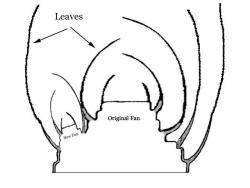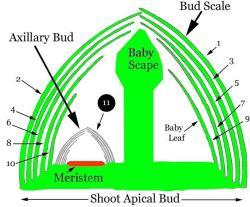beckygardener said:Maurice - THAT is an excellent photo! A photo speaks a thousand words!
Thank you.
Let me wrap my head around this .... Daylilies produce new roots and fans on TOP of the previous year's growth. So the plant should be moving UPWARD in the soil, right? Yet some are being pulled down by their roots? Pulled down more than they are growing upward? Why would that happen is the big question! What eventually happens to the old growth ... it dies off?
Think of the daylily fan as being a stem that has been squashed down. For this case a normal stem has leaves on opposite sides of the stem (one leaf on one side of the stem and then the next leaf a little further up the stem but on the exact opposite side of the stem) and then at the very top and centre of the stem is the growing point. During normal growth the growing point only produces leaves but when the fan/crown/etc/? becomes large enough the growing point stops producing new leaves and produces the scape with any branches and flower buds. Once the growing point starts producing the scape it can never produce any more normal leaves for the fan.
If the fan does not flower that growing season then the growing point becomes a bud to produce next year's fan. And it is at the "top" and centre of the crown.
If the fan does flower then a new growing point must develop on that crown and it often/usually does at the base of one of the leaves closest to the scape. So again the bud is near the centre and top of the fan. As that bud develops it slowly shifts to the centre.
When a fan divides to become two fans then either two buds develop near the scape (one on either side of the scape perhaps) or buds develop at the bases of other leaves further 'down' from the scape.
The plant would be moving upward in the soil if older lower parts of the crown do not rot away or if those parts are not absorbed by the crown or if the crown does not pull itself down.
Yes, some plants could be pulled down more than they are growing upward. There might be many reasons why that might happen. When first planted soil is 'fluffy' and has lots of air spaces. With time the soil becomes compressed. A plant that was planted at an appropriate depth in fluffly soil might become too deep when the soil settled. Soil that has a lot of organic matter will lose that matter with time and lose some of its volume and again a plant might become too deep.
In the first figure below I have exaggerated the distance between leaves to emphasize that the crown is a stem and that as it grows and develops it increases in height. My apologies for the awful drawing.

In the second figure I have shown what is inside buds of some daylilies in the autumn.

A bud scale is a special leaf on the outside of the bud. It does not grow to the same size of a normal leaf; it stays relatively short. The leaves are numbered from 1 to 10 and they would grow in the next spring. Some time after the last leaf, number 10, grows out next year, the fan will produce a scape and flower. Then the new bud, number 11, could start to grow or it could wait until later that year or until the spring of the year after. As that new bud develops it grows larger and it often slowly shifts more to the centre of the crown.
Meristem is the technical term for a growing point.


